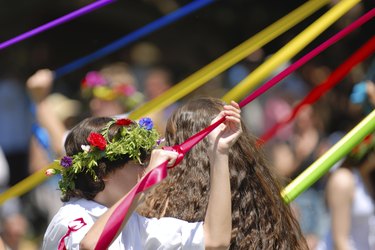
A maypole is a tall pole, historically made from the trunk of a tree, adorned with items such as flowers, garlands, ribbons and streamers and sometimes painted with stripes. The maypole is a major focus of May Day, a spring celebration that falls on the first of May, providing a centerpiece for revelers to dance around. The maypole has its origins in ancient Europe, where it was viewed as a fertility symbol. Although maypole dances also are associated with Germany and France, the maypole generally is regarded as an English tradition.
Pagan Beginnings
Video of the Day
May Day is connected to both the ancient festivals of Beltane celebrated in England by Druids and Wiccans, and the Festival of Floralia celebrated by pagans in Rome. Traditions from these spring holidays began to merge during the Roman occupation of the British isles, resulting in maypole dancing. The original maypoles usually were tall birch trees with the lower branches removed and a few top branches left intact to be decorated with garlands and flowers. Girls and young women danced in a circle around the pole, often to the accompaniment of instruments such as a tabor or bagpipes.
Video of the Day
Phallic Symbolism
The maypole historically has been viewed as a phallic symbol. When painted with red and white stripes, the white paint represents semen while the red paint represents menstrual blood. Outraged by the sexual symbolism of the maypole, Puritans fought against the maypole and managed to get them outlawed in 1644. Charles II repealed the law in 1660, resulting in permanent maypoles in the village centers of some towns and parishes. Some maypoles were remarkably tall, with the maypole erected in the Strand in England reaching 134 feet.
Ribbon Dance
Sometime after the Restoration of the English monarchy, ribbons were added to the maypole. The earliest known depiction of a maypole with ribbons is from 1759. Girls each held a ribbon attached to the maypole with the youngest girls forming the inner circle and the older girls forming the outer circle. Together, the girls danced around the pole, weaving and braiding the ribbons. The dancers then did the steps to the dance backward to unwind the ribbons. In some traditions, a girl was chosen to act as the "May Queen."
Modern Incarnations
After waning in popularity, English teacher John Ruskin revived the maypole dance. He introduced a number of new maypole dances at Whitelands College in 1881. During the Victorian era in England, the symbolism of the maypole shifted to reflect the ideals of female virtue and maidenhood. Musical accompaniment eventually came to include the fiddle, concertina, accordion and the flute as well as the recorded music of today. Modern maypole dances may employ new techniques and traditions, although they generally are derived from Ruskin's dances.